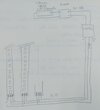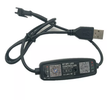Hello, total newbie here in DIY electronics (but engineer), sorry if missed an existing answer on the forum:
I'm working on a wearable light project involving 11 adressable LED strips (WS2812b / 30cm per strip) connected in parallel to a controller powered by 1 lithium battery (18650) in 5V through a booster/charger chip (see enclosed picture). All the power/control is attached to a stick hand-held (compact design).
I have several questions on which i struggle to find a solution, and i think maybe someone with more experience can help me ? I don't really know where to look for answers, it's pretty specific...
I'm working on a wearable light project involving 11 adressable LED strips (WS2812b / 30cm per strip) connected in parallel to a controller powered by 1 lithium battery (18650) in 5V through a booster/charger chip (see enclosed picture). All the power/control is attached to a stick hand-held (compact design).
I have several questions on which i struggle to find a solution, and i think maybe someone with more experience can help me ? I don't really know where to look for answers, it's pretty specific...
- I'm using 144 LED/m WS2812b strip to show a continuous line of light instead of spaced out dots (every strip is short), but at the cost of increased power consumption and harder soldering on smaller connectors. Is there a way to obtain a "light line" effect with less LED like a diffuser or different LED technology ?
- LED are actually TOO bright even at 3-5% level. If i go lower than that (1-3%), I can do less than 10 colors in total which is not enough... The solutions i found are to cover each LED with white paint (time consumming and does not reduce much luminosity), or stick 2-3 double face tape over each strip (not super strong and also time consumming, but works). Are there similar LED strips with less overall luminosity, or cleaner solutions to reduce it like ND filter tape ?
- Each of these strips is moving a lot relative to others & controller, sometimes fast. This is putting a lot of strain on the wire solderings, even though i'm using heat-shrink tubes. After a few hours of use, i got a connection failing by a wire that broke next to the solder. I tried finding proper connectors to avoid soldering, but they are usually too big (should be as flat as possible), or allow connection of only 1 wire (impossible for my parallel circuit). Any idea to have stronger connections on each LED strip ? What about crimping headers + heat shrink ?
- My whole system is an assembly of separate components:
- battery case
- booster 5V/recharge/protection card
- on/off switch to isolate the controller (else it's drawing power even when LED are off)
- controller
- Any recommendation on where to look to find a way to encase these different components in a "long" case to be attached to a stick carried by hand ?


